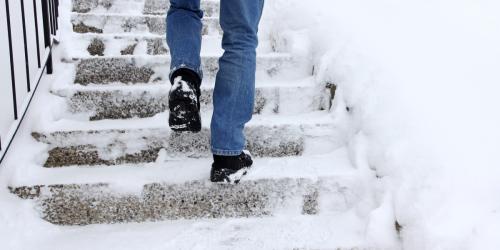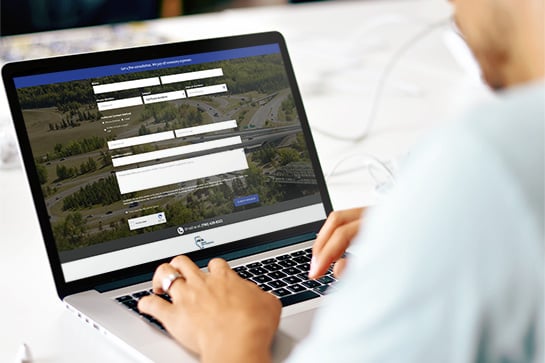Walking on city sidewalks in Alberta in the winter and colder spring months can be treacherous. Many homeowners neglect to shovel the snow on city sidewalks in front of their homes following a snowfall, even though city and town bylaws require them to do so. In Edmonton, the city bylaw requires that a homeowner shovel the city sidewalk that runs alongside their property within 48 hours of the snowfall – in Calgary, the requirement is within 24 hours. Even if a homeowner shovels the city sidewalk, and perhaps also sands or salts, the sidewalk can remain treacherous, and pedestrians can slip and fall. Given that homeowners are required by the municipal bylaw to shovel the snow, are they liable for any injuries you suffer should you slip and fall on the sidewalk adjacent to their property?
This exact issue was raised in a 1998 Alberta case, and, the short answer is no. The duty to clean the sidewalks under the municipal bylaw will not, on its own, give rise to any homeowner liability.
When are property owners liable for injuries that occur on their property?
The Alberta courts have looked at the issue of homeowner liability in a broader context, however, and considered whether the homeowner who fails to clean the city sidewalk can be liable for reasons other than the simple breach of a municipal bylaw. This 2001 Alberta decision, upheld on appeal, establishes that in most cases a homeowner will not be liable, but there are some circumstances in which a homeowner could be liable. For example, if the homeowner has exercised “control” or “possession” over the city sidewalk, or if “special circumstances” arise, then the homeowner could be liable.
What are “special circumstances” that might lead to liability?
“Special circumstances” could include the homeowner creating a hazard on the city sidewalk, such as allowing water to pool and freeze on adjacent public walkways.
This is illustrated by this 2007 Ontario case where the homeowner allowed water to overflow from a downspout and create a hazardous ice formation on a city laneway. The overflow occurred because the homeowner had not cleared debris and plant waste from the property and that impeded the drainage from the downspout.
What do you have to prove to succeed on a slip and fall claim?
To succeed on a slip and fall claim the first step is to show that you were injured as a result of an accident on someone else’s property, and second that they are at fault.
Usually, this involves proving the property owner has contributed to the dangerous conditions or been negligent because they failed to remove them.
Typical examples of dangerous conditions leading to slip and fall accidents in Alberta include:
- Uneven flooring
- Unsafe stairwells
- Drop-offs
- Wet floors
- No fencing or warning signs in place for construction projects
- Failure to keep public walkways free of hazards
Slips or falls outdoors are mostly due to snow and ice here in Alberta, but can also due to potholes and hidden hazards at any time of year.
The third element of a slip and fall claim is proving that you suffered an injury as a result of the fall and that you have suffered a loss. Proof includes medical documentation of your injuries and evidence you have sustained a loss, e.g., loss of income due to time off work, out-of-pocket costs for rehabilitation and medical expenses, ongoing pain and suffering.
Property owners are not always liable
Property owners can avoid liability if they can show that they took reasonable steps to avoid or remove the dangerous or hazardous conditions that led to your injury. If the property owner was aware of the dangers and did nothing to correct the situation or the danger was present for long enough that they should have taken action, then they may be liable for damages.
Special considerations apply when the property “owner” is a municipality
When it comes to injuring yourself on city property, there are some things to keep in mind.
First, the obligations of a city or municipality are different than an individual or business, and they are set out in the Alberta Municipal Government Act. The standard you must prove to succeed on a slip and fall against a municipality is one of “gross negligence” which can be hard (but not impossible) to prove.
Be aware that different limitation periods apply when the property owner is a municipality
Unlike a personal injury claim against an individual or business, there are special limitation periods that apply to making a claim against a municipality. In Alberta, if you intend to make a claim for a slip and fall injury that occurred on the municipal property, you must inform the municipality of your injury within 21 days after the fall. There are some limited exceptions to this time limit.
A personal injury lawyer will be able to tell you what your chances of success are and if you’ve missed the 21-day limitation period, he or she can tell you if you fit within one of the exceptions.
What to do when you slip and fall
If you slip and fall on someone else’s property and sustain an injury, your priority should be to seek medical attention for your injuries. If possible, try to get photographs of the location at the time of your fall. Make a note of the footwear you wore, identify any witnesses and make sure your injuries are thoroughly documented by your doctor and that you follow the treatment prescribed. Further, make sure you keep all receipts related to your injury. For example, if you had to rent crutches, buy tensor bandages, pay for taxi cabs to get around or you had to purchase prescribed pain medication keep all those receipts.
Why work with a personal injury lawyer?
To get the compensation that you deserve for your slip and fall in Alberta, you will have to make a claim against the property owner, and prove their liability through their negligence. This requires establishing how the property owner is (not always straightforward), presenting relevant documentary evidence of your injuries and losses, and handling the testimony of witnesses. Further, you need to be aware of, and comply with, any time limitations that apply and what documents need to be completed and filed.
The experienced personal injury lawyers, at CAM LLP, know the law involved and can evaluate your case to confirm you have a valid claim. We can make sure you don’t miss any time limits and help you gather the evidence required to identify the correct property owner, prove their liability, and establish your injuries and your losses.
Having a personal injury lawyer deal with the paperwork and insurance company lawyers means you can focus on your recovery, secure in the knowledge that your interests are being protected.
If you have questions about a slip and fall claim, call us for a free consultation.

